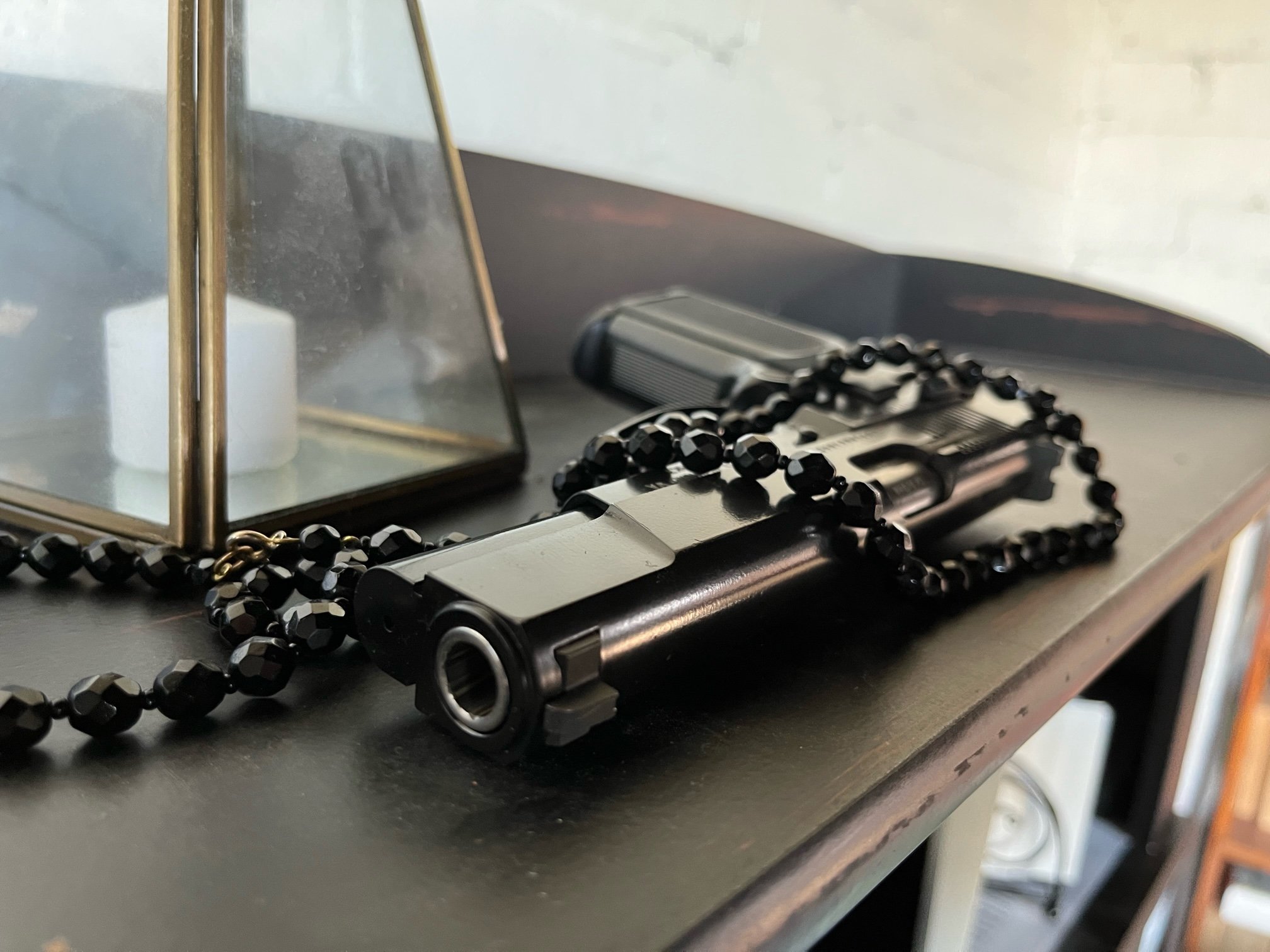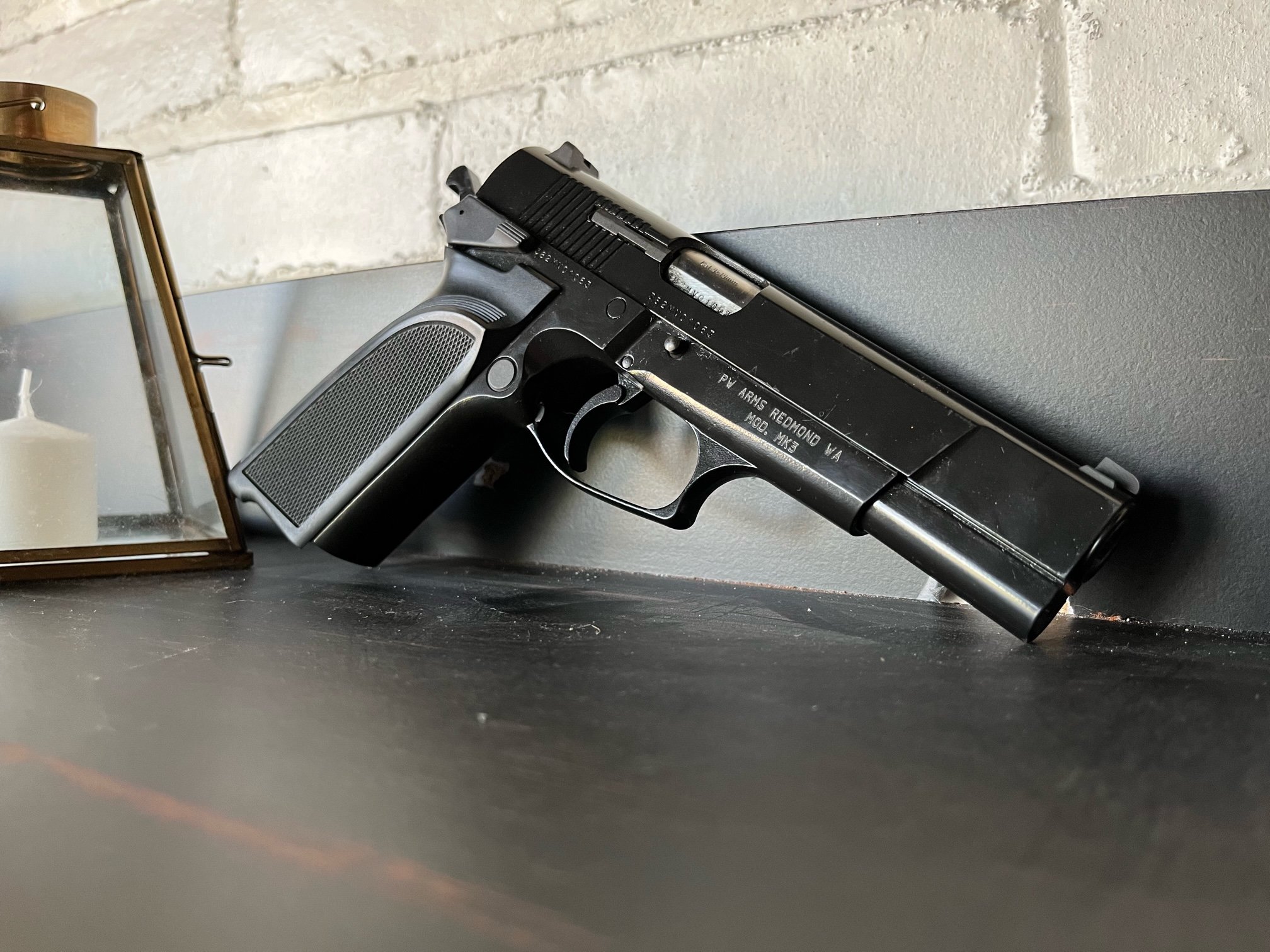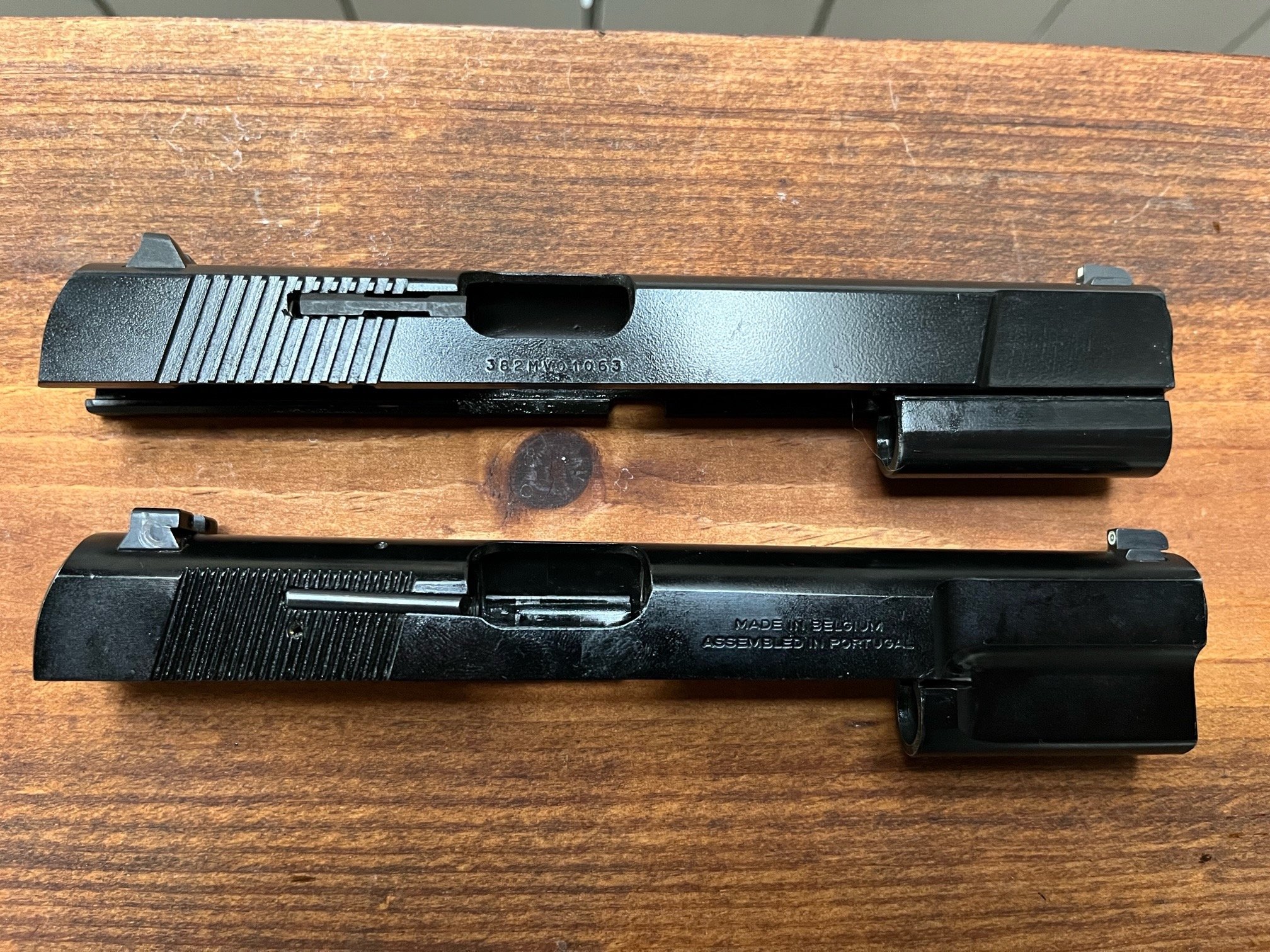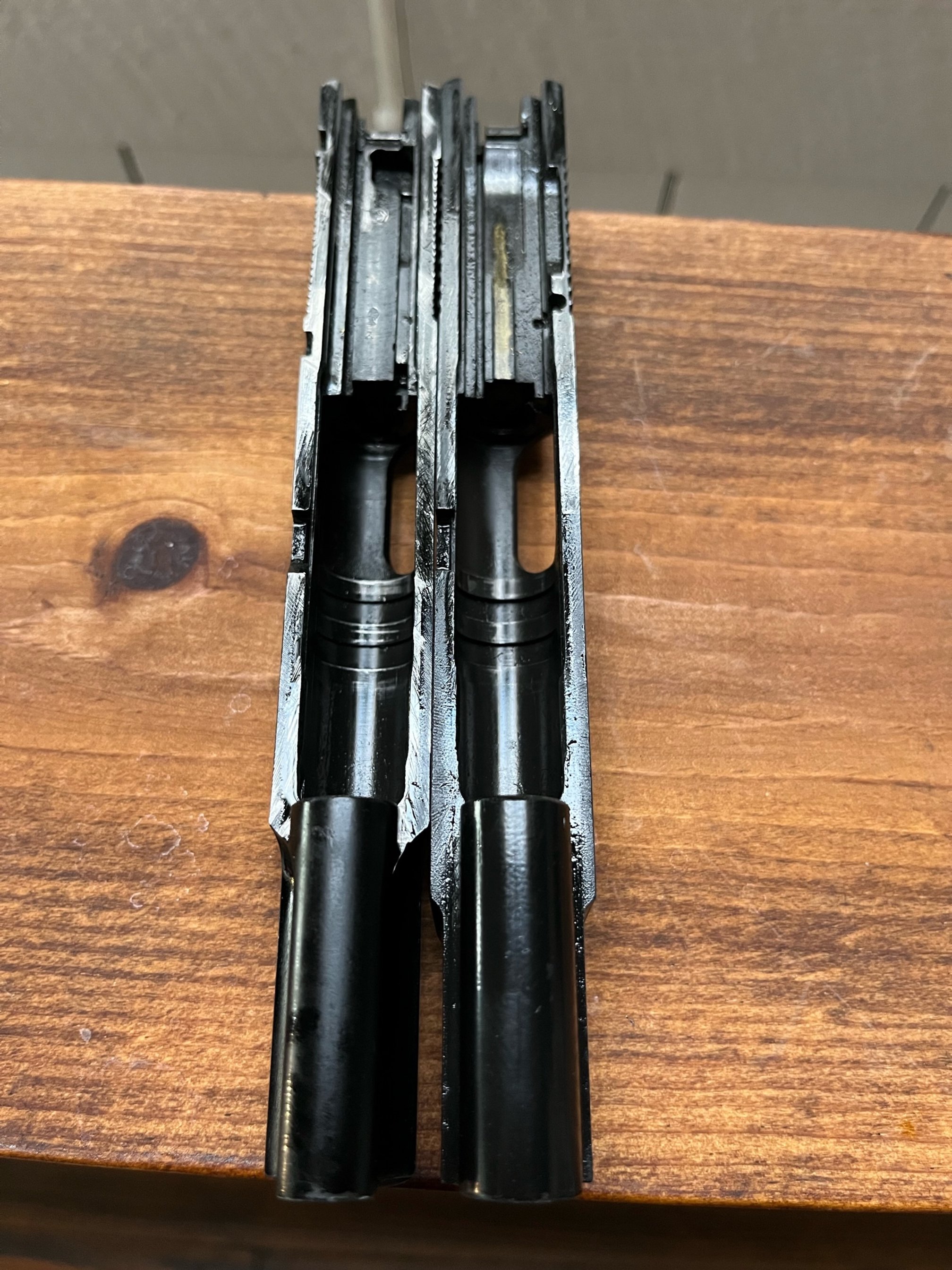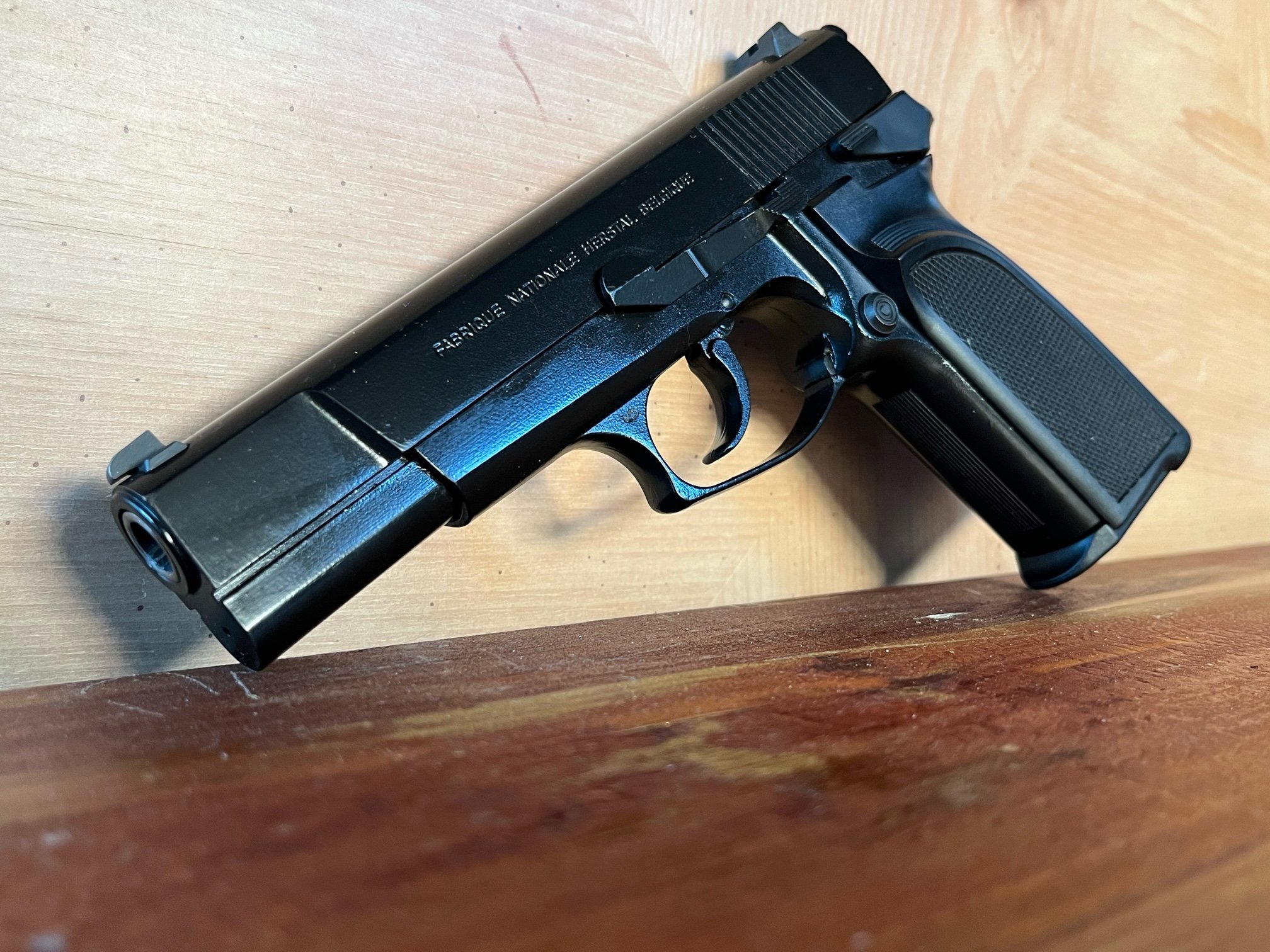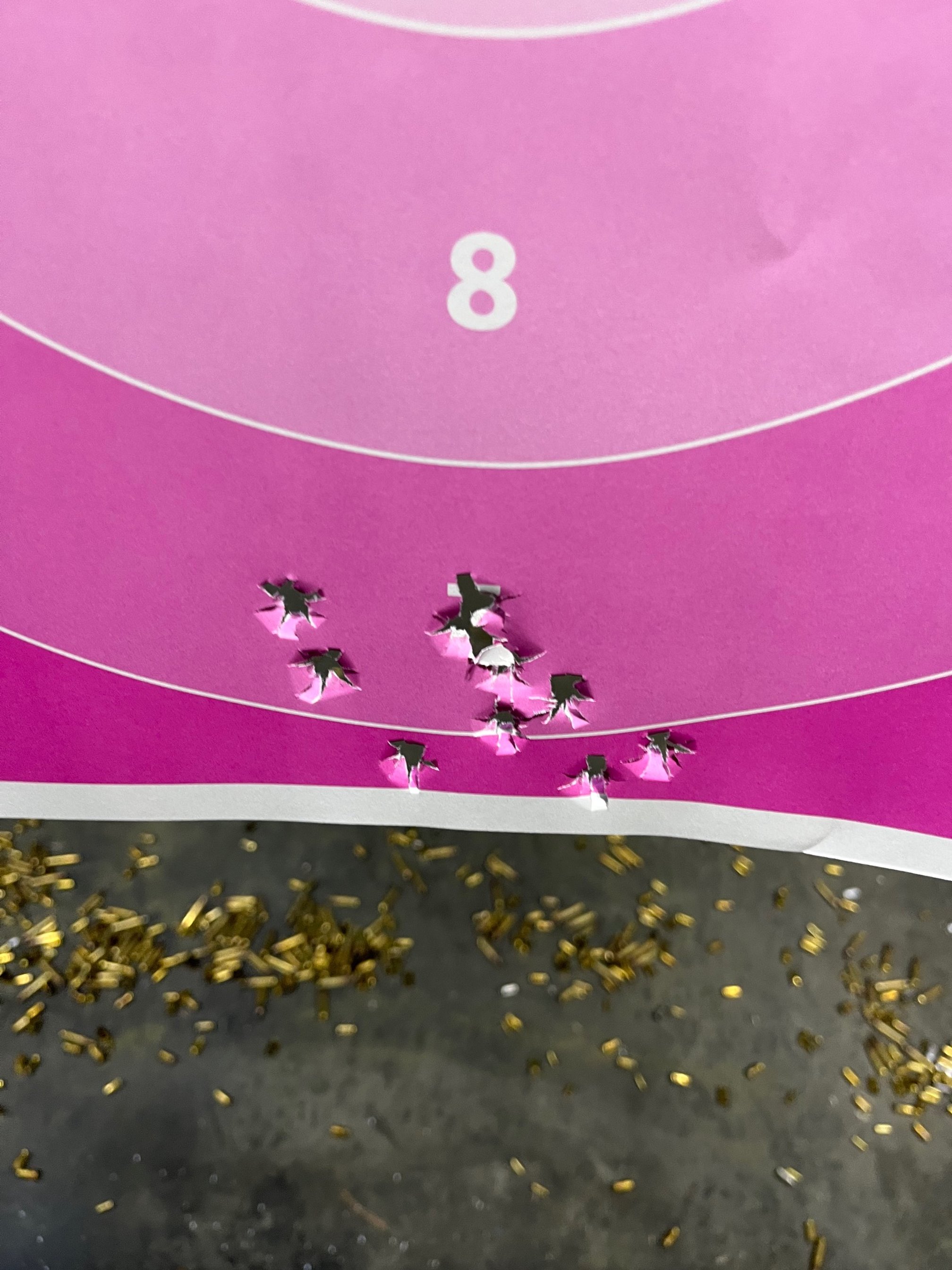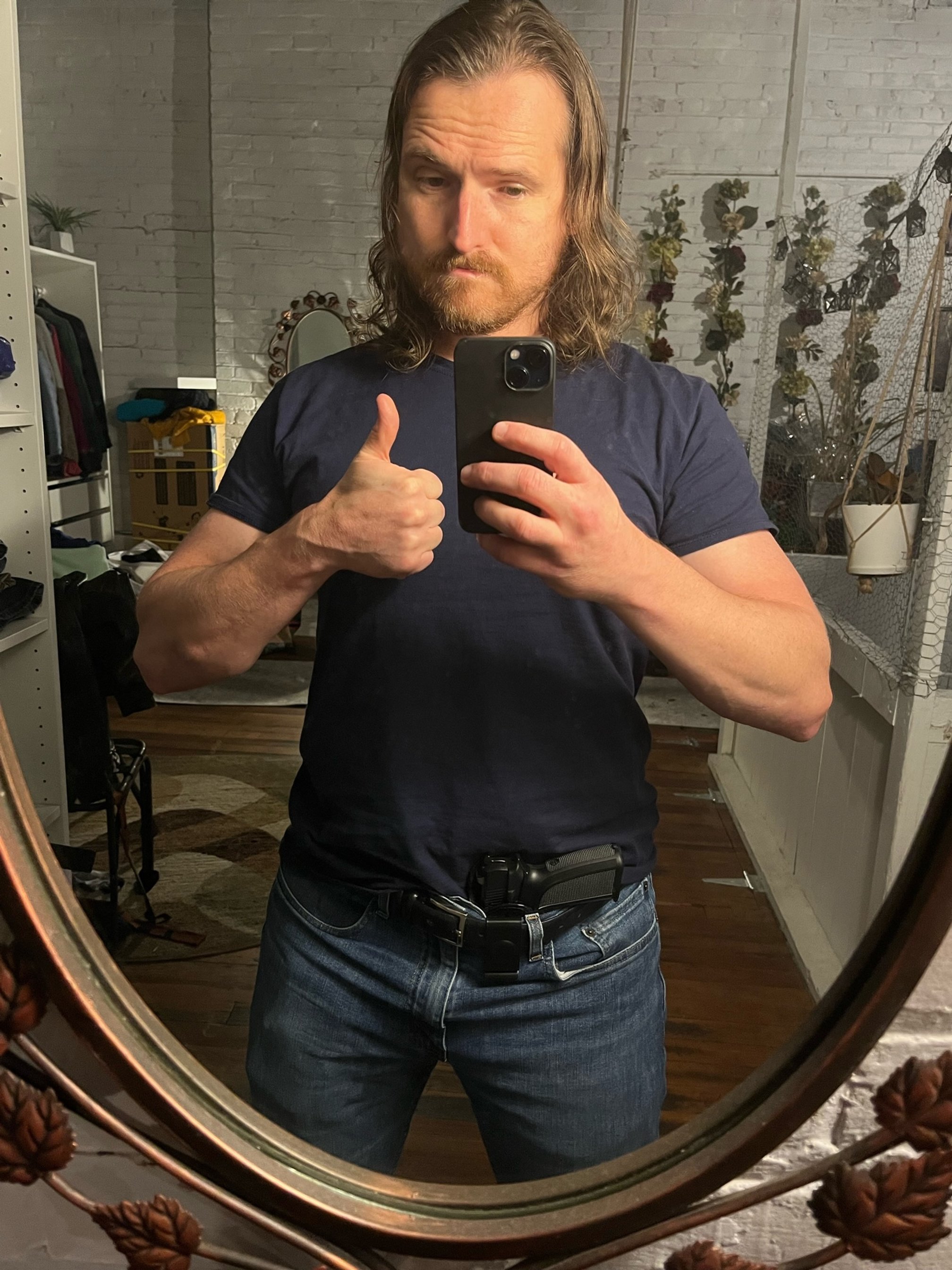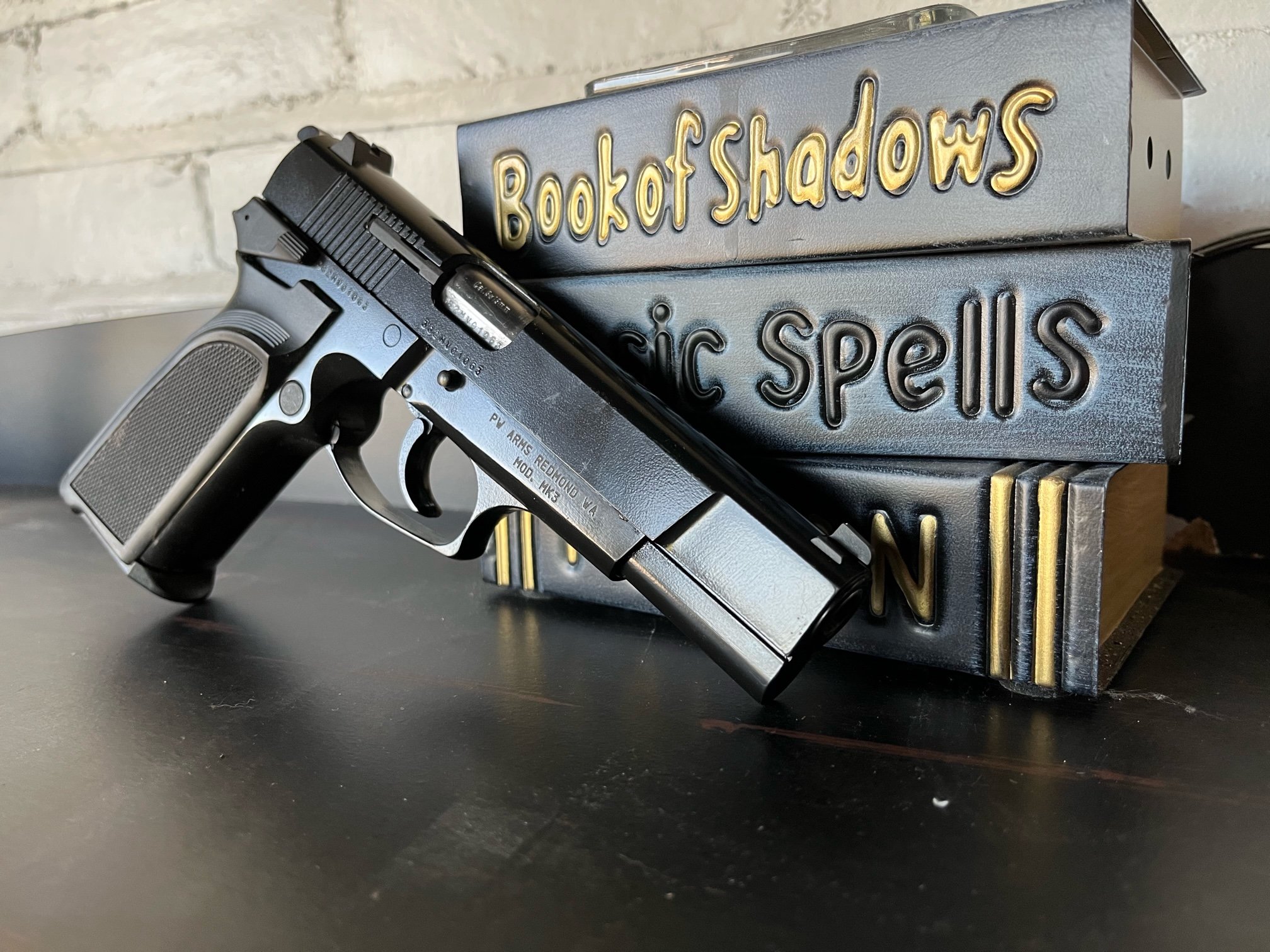FN HP-DA / BDA9 Review: The Mysterious DA/SA Hi Power
A shadowy form beckons.
Dark. Lonely. Forlorn and forgotten. Yet somehow familiar.
But not as you once knew it.
In its dusky silhouette, a vague memento of the past lingers. Another time. Another life. A fleeting echo of something you once felt and even… loved.
And that’s what haunts you. Yet, compels you—as you gaze upon its sinewy, angular visage.
The FN HP-DA is steeped in enigma… and creepy beads.
In so many ways, it is the Browning Hi Power for which your heart once burned. Yet it is different. Altered. Transformed by the darkness. A darkness that you now embrace. Willingly. Voraciously. Only to realize…
“The FN HP-DA is one helluva nice pistol. Even if it’s not an actual Hi Power.”
Or is it??
Ch, ch, ch, ch… ah, ah, ah, ah
So then, let us face the forbidden mysteries of FN’s oft-forgotten double-action wondernine… together. And dare to ask…
What makes the FN HP-DA hipster worthy?
The FN HP-DA conjures an alluringly graceful mystique, combining the svelte poise of the original Hi Power with the sophisticated design of a modern DA/SA combat pistol.
The HP-DA is a ghost.
A wraith. A specter. A phantasm. An urban legend. Hell, I’m surprised gun hipsters don’t stand in front of mirrors repeating “BLOODY BDA” until a gore-stained pistol emerges and drags them back to… umm, Belgium.
There’s just enough about it on the internet to hint that some kind of a modernized, double-action Hi Power variant exists… somewhere. But no one’s seen it. No one knows anything about it. No one really even knows what to call it.
Including FN, apparently.
What’s in a Name?
Depending on who you ask, where and when, it’s sometimes called the HP-DA (Hi Power Double Action) and sometimes called the BDA-9 (Browning Double Action). I’m gonna stick with “HP-DA.” Because that seems truer to what this gun really is than anything.
To that point…
In many ways, the HP-DA literally is a Browning Hi Power with DA/SA guts. In fact, I would argue that it’s more of a true Hi Power than the “High Power” FN introduced earlier this year (2022).
But it’s also a very different gun from the original Hi Power. It feels different. It shoots different. Its subjective character and its essential qualities are just different.
I conjured a wondernine…
So where does that leave us?
It leaves us with a very interesting gun that (with the exception of the Finnish armed forces) failed to capture the interest of very many—even though it was basically FN’s flagship handgun product in the ‘80s and ‘90s. In fact, modern gun culture seems perfectly comfortable believing the HP-DA never existed at all.
But it does exist. Much like sasquatch. And shadow people. And contemporary west-coast rap. And by the end of this review, I will make you a true believer… in the legend of the FN HP-DA.
Believe…
The Legend Begins
And, like most legends, this one remains shrouded in the mists of time, fate and really shitty product portfolio management. Nevertheless, it begins somewhere shortly before the XM9 trials of the 1980s…
As the United States geared up to replace the 1911 with a modern DA/SA 9mm, nearly every major handgun manufacturer wanted a piece of that phat government-contract pie. Of course, Beretta had the 92. Sig was gathering steam with its P2XX line. And Smith & Wesson had its 459s and 439s.
And FN?
Had the venerable Browning Hi Power—aka, the P35. Which absolutely wasn’t gonna cut it, with its old-fashioned single-action only lock work.
But FN also happened to have a designer named Leon Hubert (hu.BARE). In the mid ‘70s, Hubert designed the thoroughly modern, and thoroughly double-action, BDA .380—aka, the FN 140DA. While FN outsourced production of the BDA .380 to Beretta (which eventually spawned the Beretta Cheetah series of guns), the handsome “Belg-talian” .380 saw some degree of law-enforcement service in Europe during the ‘70s and ‘80s. Apparently, it earned a reputation for quality and reliability.
And apparently Mr. Hubert earned a reputation for designing mad-decent guns.
I see the ensuing dialogue going something like this…
FN: You know how you designed that double-action .380 that everyone seems to like?
Hubert: Yup.
FN: You know how we have a single-action 9mm that everyone seems to like?
Hubert: Yup.
FN: Can you, like, put those two things together? In one gun? That can win the largest handgun contract in history?
We all know how that turned out.
But…
Before we speculate as to how/why/when the HP-DA bowed out of the XM9 trials, let’s talk about how Mr. Hubert imbued the venerable Hi Power with some DA/SA black magic.
A dark spirit manifested… who happens to like belly rubs.
Hi Power at Heart
Caveat: I get into more technical detail, here, than I do in most of my reviews. But I was curious about how the mechanics of this thing compare to an “actual” Hi Power. So, I figured y’all might be too. Also—I’m not an engineer. So, I did my best to explain this stuff in layman’s terms.
Despite its many departures from original Browning/Saive design, the FN HP-DA still has the beating heart of a P35. And since I have an MKIII Hi Power that was made in the same general timeframe, I can give you a halfway decent comparison. I also happen to have a Browning BDM, which—while not mechanically related to the Hi Power family—is worth mentioning because it kinda shows some patterns in FN’s thinking in the ‘90s (FN owns the Browning brand, BTW).
Left to Right: MKIII Hi Power, FN HP-DA, Browning BDM
So, looking at the MKIII Hi Power and the HP-DA…
The barrel, the feed ramp, the concentric locking lugs and the linkless camming slot—all of which define the intrinsic mechanics and dimensions of the pistol—are basically the same. So is the slide, for the most part… aside from having sidewalls that taper out to a slightly greater width. Plus, the HP-DA has a huge Freddy-Kreuger-esque extractor claw that makes the MKIII’s extractor look like a glorified crochet hook. It’s the coolest, most aggressive, most heavy-duty-looking extractor I’ve ever seen on any gun.
Who knew extractors could be sexy? Leon Hubert did, apparently.
Look at that epic extractor on the HP-DA (top).
But…
Despite the obvious lineage from the Hi Power, none of these components will interchange between HP-DAs and P35s. Everything has slightly different cuts, contours, clefts and/or angles that preclude any crossover.
Coincidence? I think…
Well… I think we need to talk about the rest of the gun.
Barrels look like they came off the same machine. But you can see the cut on the HP-DA’s camming lug (left) which gives the trigger bar clearance. You can also see how the contour inside the camming slot is different and the notch that holds the guide rod is different.
Below the Belt
Getting down into the fire-control setup, the HP-DA has basically nothing common with the Hi Power.
Instead of running the trigger/sear linkage through the slide (like all single-action HPs), the HP-DA uses a fairly “normal” trigger bar that runs along the inside of the frame wall. But to preserve the svelte profile of the gun, the forward camming lug has a slight cutout (see pic above) on the right side to make room for the trigger bar. The contour within the camming slot is also more rounded because the cross-bar thingy that the barrel cams against is round instead of oblong. Furthermore, the HP-DA’s guide rod doesn’t have that little “ring” to capture the slide-stop pin, so the notch that retains the guide rod is different.
So, given these tweaks, a normal Hi Power barrel would never work in an HP-DA. Or vice versa.
Also…
The top/front of the mags had to be “pinched in” to give the trigger bar clearance. This is why OG Hi Power mags will NOT work in an HP-DA. They go in all the way, but the trigger bar rubs on the front of the mag in DA. Now, P35 mags will feed in an HP-DA IF you hold the mags in the gun. But they don’t latch because FN changed the mag-catch cutout. I guess they didn’t want people using mags that weren’t fully compatible with the gun.
However…
HP-DA mags will work just fine in an OG Hi-Power. And they’re really good mags—they hold the rounds at a slightly higher angle than typical Hi Power mags and the follower seems very stable. I’ve heard they’re made by Mec-Gar? But I can’t confirm that.
The HP-DA’s sear also moves deeper into the gun, presumably to interface with the lowered (i.e., frame-mounted) trigger bar. Compared to the Hi Power’s “horizontally opposed” sear, the HP-DA’s is more vertical, pivoting from the top; it engages a notch on the bottom of the hammer shank. And, of course, the trigger bar connects with the hammer to achieve double-action functionality.
OG Hi Power frame on the left, HP-DA frame on the right. You can see the trigger bar on the right in the HP-DA.
Moving the trigger/hammer linkage down to the frame also means the firing pin safety (FPS) had to be moved along with it. The FPS on the MKIII Hi Power is cleverly built into its slide-mounted trigger bar: since it’s basically a cantilever/see-saw kinda thing, there’s a spring that pushes down on the front of the bar, so the back end pokes up into the FP channel. Then… you pull trigger… the front of the see-saw moves up… and voila.
Seamlessly disengaged.
Well, that design isn’t an option with the HP-DA. No slide-mounted see-saws, here. So, Mr. Hubert designed the firing pin stop (that little plate thingy on the back of the slide where the firing pin pokes through) to raise up when you pull the trigger, then come down as you release it.
When it’s down… it occludes the firing pin. When it’s up… it doesn’t.
Smart shit.
I’m gonna guess that the Hi-Power/HP-DA slides are just tooo small and narrow to have room for a more typical plunger-style firing-pin safety. I applaud the innovation, either way. It’s really a cool—dare I say “nifty”—design.
MKIII left; HP-DA right. Very similar, overall. But you can see the HP-DA lacks the cantilever that acts as the trigger bar (and the FPS in MKIIIs).
It’s worth noting that (I think) Leon Hubert is also responsible for most of the engineering improvements that went into the MKIII Hi Power, circa ~1988—including the cantilever-ish FPS I described a few paragraphs ago. Clearly a brilliant guy with some elegant and interesting designs to his credit.
Speaking of interesting…
The HP-DA’s hammer is powered by a unique “mousetrap” spring instead of a traditional “coil-on-a-strut” setup. I’m not sure what benefit this provides, other than reduced complexity/parts—and a somewhat “different” trigger feel, which we’ll get to.
Also, the grip-frame/magwell of the HP-DA is more “open” in the rear—it lacks the solid metal backstrap you find in a true Hi Power. Instead, the HP-DA uses a simple one-piece plastic grip that screws into the back of the magwell. This may be a function of that weird mainspring: you don’t need to bury a big ‘ole hammer strut and sear spring in the grip.
The magwell is very “open” in the HP-DA—and you can see the unique “mousetrap” mainspring peeking down from under the “tang.” That stud with hole in it is where the one-piece grip screws in.
Regardless…
Without the steel backstrap, the HP-DA feels less “back heavy” than an MKIII Hi Power. Though I’m not 100% sure that’s a good thing. More on that later.
An Ensemble Cast?
I’m gonna go ahead and guess that the HP-DA’s frame uses the same investment-cast steel metallurgy used on the MKIII Hi Power’s frame. The character of the metal/construction seems similar; both guns feel like they’re kinda “cut from the same cloth.”
Now, I don’t know if the HP-DA’s slide is also made from a casting. As far as I know, the MKIII Hi Powers never had cast slides (only frames). But that doesn’t mean the HP-DA doesn’t. Also, the fact that the slide’s sidewalls taper out to a slightly greater width may indicate an effort to mitigate the greater porosity inherent to cast parts. But that is pure conjecture.
They may have just thickened up the slide to increase reciprocating mass or improve durability. And we’re talking barely a millimeter, here—the HP-DA is still a super-thin gun. Which is awesome.
Interestingly, the contemporaneous Browning BDM definitely does have a cast slide. In fact, I tend to think at least some of the gun is welded together—but I can’t be sure. And to me, the BDM feels NOTHING like the MKIII or the HP-DA. While it does share the mousetrap mainspring and a similar one-piece grip unit with the HP-DA (apparently people were talking), I think it’s safe to say the BDM is not related to the Hi Power family in any way.
And though the BDM feels solid and well put together, it also feels rougher and less refined than the FN-produced guns. Both my MKIII Hi Power and my HP-DA feel like extremely high-quality pieces of machinery. And I tend to think the HP-DA feels even more nicely fit. The slide thunks into battery with grace and gusto. The barrel fits perfectly, muzzle to breech. The slide/frame tolerances are seamless, yet fluid.
You get the sense that it’s not a “consumer” product. It’s a superbly executed piece of military-grade engineering. And it feels like it, in every way.
The shadow warrior. The HP-DA feels like a purpose-built combat pistol. Which it very much is.
No, it’s not quite on the “semi-custom” level of my Walther P88c (for instance)—but it exudes quality, through and through. Everything feels crisp, precise and extremely well fit. I know castings are often seen as the “cheap” alternative to forgings, but trust me: nothing on this gun feels cheap.
In fact, the HP-DA feels…
Like it’s ready to go war. And that’s precisely why it was designed.
So, now we know what kind of mettle (and, umm, metal) this thing is made of, let’s get back to the ‘80s…
[Cue montage with “Push it to the Limit” from Scarface]
The Legend Continues
By 1983 FN had a prototype of the HP-DA ready to roll, which they submitted to the US for evaluation in their mind-boggling litany of highly biased pistol trials that had been taking place since the late 1970s—which, collectively, came to be called the “XM9” trials.
From what I can dig up, the HP-DA participated in the 1984 trial. Which, I guess, was the most definitive phase. All I can tell you for sure, is that FN didn’t win the contract. There’s really no concrete information (that I’ve been able to find) on how it performed or why it was withdrawn. Even books on FN handguns (like, legit tomes of paper and glue) just seem to ignore this pistol. It’s weird.
On one random thread, someone mentioned “teething problems” and FN’s desire to avoid a poor showing—so as not to “taint” the pistol’s reputation for forthcoming commercial sales. But that’s about as much texture as I could find.
Anyway…
After the Beretta 92 was crowned as the undisputed champion of the wondernine world in 1985, FN had this modern double-action service pistol laying around. Some sources indicate they started selling the thing around that time. Or trying to.
I guess it didn’t go particularly well.
Because, by the early ‘90s, FN had refined the design into what amounted to a “second generation” version of the HP-DA.
Now, EVERY picture I’ve EVER seen of an HP-DA (on forums, Gunbroker listings, articles, blog posts, etc.) has been of this “second generation” version—EXCEPT for one lowly thumbnail on Wikipedia, which shows the “first gen.”
The decocker looks different.
That’s about the only distinction I can see between the first and second gen. And… to be clear, the one I own is the only one I’ve ever seen in person; it’s a “second generation” example.
So, finally, in 1990 / 1991 FN managed to sell their “second gen” HP-DA to Finland. It was adopted as the 9.00 PIST 80–91 became the standard-issue pistol for the Finnish armed forces. As of 2022, I’m not sure if the Finns are still using HP-DAs. One somewhat recent forum thread seemed to suggest that spare parts were getting scarce. So, I wouldn’t be surprised if it’s being phased out in Finnish service. Maybe it already has been.
The HP-DA may have seen other contracts too. But Finland was the definitely FN’s biggest customer for the gun and the only military contract that anyone ever references, specifically.
As far as I know, that’s where the HP-DA’s military career ends. Which seems a little… sad? Because, in my ~350 rounds with it, I’ve come see it as a really, really good pistol.
Will it do anything a Beretta 92 or a Sig P226 won’t do? No, not really. But it will do it with a uniquely slender, svelte mystique that probably fits more hands, handles more naturally, and is likely a little easier to carry, day in and day out.
Sometimes the props don’t cooperate…
How Did the HP-DA Fair on the Commercial Market?
From what I can “indirectly glean” from its presence in online discourse… not great.
It seems to be much more prevalent in Europe and potentially other parts of the world, outside of North America. I’ve seen a few videos in Turkish, on YouTube—in one, a gentleman discusses it for a few minutes. Unfortunately, I don’t speak a lick of Turkish, so I wasn’t able to learn anything from that. A video from “Bloke on the Range” in Switzerland also discusses it briefly; the way he talks about it suggests that HP-DAs (he calls his a “BDA-9”) aren’t quite the moonrocks that they are here in the states.
Yet, it was sold commercially here in North America. For a brief stint in the early 2000s, I believe. In fact, I scrounged up a Guns Magazine article from 2001 that covers it. That article suggests it was sold by FN (not Browning) as a law-enforcement product, but still could be purchased by private individuals.
And while the rehashed platitudes on the internet suggest it was called the “BDA-9” in the US and the “HP-DA” in Europe… I kinda think it was the other way around.
I’ve read that Browning didn’t want to import this thing in the ‘90s because they wanted to sell the BDM domestically. Then, fast forward to the early 2000s after the BDM flopped… we have FN importing the HP-DA as a quasi-LE offering.
Seems to me they sold this as an FN product and Browning had nothing to do with it.
Plus, every commercially imported example of this gun I’ve seen on Gunbroker, etc. has been marked “HP-DA” with an FN-branded box (if there was a box at all).
And I think that’s a big reason for this gun’s absence from handgun canon in the United States: It never really fit into the whole “Browning” narrative.
And if it wasn’t a Hi Power… what was it?
Let’s talk about that.
Heart & Soul
While the HP-DA has the heart of a Hi Power, it doesn’t really have the soul of a Hi Power. Yes, it retains the slender, eminently pointable grace you find in a Hi Power… but you experience that in a different way.
If grabbing a Hi Power gives you “the warm fuzzies,” holding an HP-DA gives you the “cool slickness.” If the Hi Power is Grace Kelly in Rear Window, the HP-DA is Kate Beckinsdale in Underworld. It’s smart. It’s suave. It’s dark and seductive. It feels precise, efficient and intentional.
And so does every shot you take.
I take no issue with Selene using chrome-plated P99s in Underworld. But the HP-DA definitely coulda’ been a contender…
Take Your Best Shot
BANG! BANG!
It’ll stack holes on holes at 10 yards.
50 rounds @ 10 yards. A teeny bit low left, but you can see the group is very tight and precise. Just a few flyers ‘cause I suck.
BANG!
The single-action trigger is crisp, light and precise. But it’s honestly a little “touchy.” It feels less direct than other SA triggers. Maybe a bit hollow? It’s like you can’t really sense the sear about to release, like you can in other SA triggers. I’m thinking it might have something to do with that unique “mousetrap” mainspring.
It’s certainly not a bad trigger, by any means. It’s just little unpredicta—
BANG!
—ble.
But if your cool trigger-control skillz can match the HP-DA’s cool vibes, it will reward you with incredibly precise shot placement. I don’t know if it’s more accurate than my MKIII Hi Power, but sometimes it feels like it.
Click… BANG!
And if you decock, you’re treated to a wonderfully shootable DA stroke. That uniquely light action—which can feel a bit abrupt in SA—makes for a smooth, seamless pull in DA. You don’t feel that escalating tension like you do when you’re pulling against a “normal” coiled mainspring. Again, it still feels a bit hollow and vague. But… targets don’t lie. I pulled some of my better DA-only shot groupings with this gun.
That said…
@ 10 yards, decocking between shots. This gun is VERY shootable in DA.
Feel Matters
And, to be clear, the HP-DA feels good in the hand. Really good, actually. But “good” in a more dispassionate, functional, kinda way. While the Hi Power gives you a visceral sense of connection to the gun, the HP-DA gives you… well… exactly what FN’s corporate design team wanted you to feel back in 1983.
The ergonomics are very deliberate.
The grip has thoughtful curves, shelves, angles and contours that speak to a very specific vision of how you should interface with the pistol. And—for me—that vision seems to entail shooting an inch or so left of where I’m aiming.
Just a touch.
Now, the BDM—on the other hand—shoots waaaaaay left. Like, it’s not even close. I’ve never shot a gun that hits so far off POA. The sights seem aligned. The bore seems straight. I dunno? It groups pretty well and it’s reliable. But, for me, it’s basically unshootable.
The HP-DA is nothing like that. I tend to think the gun’s “deliberate” ergonomics are just a bit more sensitive to shooter inputs than some guns. For instance, the sides of the HP-DA’s grip angle inward toward the front strap. So, you’ve gotta pivot your support hand in to match the angle of grip AND maintain enough pressure to keep it from rotating left. Add that to a somewhat touchy trigger…
You can’t be lazy with this thing.
And I tend to think that solid steel backstrap on the original Hi Power pays dividends in terms of keeping the gun planted in the hand. The HP-DA’s grip is bigger and fills the hand better, but it’s no substitute for a little extra junk in the trunk behind the slide.
Also, the sights aren’t great. Instead of 3 white dots, you get 3 little white squares. To me, a square doesn’t “pop” as much as a round dot. But sights are subjective. And I do think some the commercially imported HP-DAs (of which there were, like, 11) did come with dots as opposed to squares. But I think those sights were actually plastic? Which seems kinda janky…
The grip has very “intentional” contours—which I honestly don’t love. You can see I added some grip tape… but removed it for the review.
Now, after a few range trips, some skateboard tape and “Sharpie’d-out” rear sights, I felt like I was able to sort out these quirks, for the most part. In fact, I was very happy with the 50-round group I put up in my last trip. The gun is DEFINITELY accurate. And, overall, it’s a very nice shooter. Soft. Pleasant. Easy to shoot fast. Just as you’d expect from an all-steel pistol with a 4.7-inch barrel. But you have to focus. You can’t rush it.
Another thing that kinda sucks…
You Get What You Get
Your aftermarket grip and sight options are basically nonexistent. Hi Power sights won’t fit the dovetails (I checked). And your only other option for grips is KSD in Turkey. Now, I like the KSD grips I have on my Smith & Wesson 6904. But KSD basically creates exact facsimiles of factory grips… which, as we’ve discussed… are kinda goofy on the HP-DA.
I might order some KSDs at some point. But, I’m not really expecting much of an ergonomic departure from the factory grips. I’ve also considered taking a Dremel to a pair of factory grips (which you can buy on Numrich) for a “recontouring” job. We’ll see.
Also, magazines are _uckin hard to come by.
As I’ve said, Hi Power mags will NOT work in the HP-DA. However, BDM magazines WILL. But I’ve noticed the feed lips are a little different; the BDM mags hold the rounds at a slightly lower angle. That said, I ran quite a few rounds through this gun with BDM mags. No stoppages. But I prefer to use the “native” HP-DA mags. And I tend to think it fed a little more smoothly with those? But maybe that’s just my imagination.
Speaking of “native” HP-DA mags…
The neutered, ban-era 10-round HP-DA mags seem to pop up online, from time to time. But the standard 14-rounders are basically unobtainium. At least in the United States.
My gun came with just one 10-rounder (which is probably why it was a decent price). That said, I managed to score TWO 14-rounders through shrewd and draconian Gunbroker tactics. Check out the video review if you wanna hear how I swung that.
So, Why Own an HP-DA?
Well… it’s a curiosity.
An interesting footnote in handgun history. An homage to FN’s less-than successful efforts to embrace the wondernine revolution of the 1980s. If you run across one, you probably aren’t gonna carry it in any sort of defensive capacity.
But you can bet your hipster ass I will.
Honestly, this gun checks some key boxes in terms of carry, for me. It’s soooo slender. And that, to me, is a huge selling point for P35-based guns. In a sense, the Hi Power and its descendants are inherently compact pistols—just with long slides. The cross section of the guns is just smaller than most service pistols. Case and Point: My Hi Power and my HP-DA will fit in a Kahr arms holster (it’s an open muzzle design). Perfectly. Sigs, Berettas and even my Walther P88c won’t come close.
That’s a Kahr PM9 holster. No joke.
So, the HP-DA is very comfortable in the waistband. Obviously, the OG Hi Power is too, but it’s SAO. Not that I’m opposed to carrying C&L, but I prefer DA/SA overall. And, with a decocker, you don’t have to deal that meat-grinder of a hammer poking into your gut.
Obviously, the BDM checks those boxes as well. And it also carries very, very well. I just can’t shoot the damn thing.
And as the cool embrace of autumn descends upon the mystical realm of the midwestern United States, it’s going to make a very comfortable full-sized carry option. I may continue to pursue better sight and grip solutions, but I’m generally happy with how it shoots and handles, as is.
Plus, it’s been 100% reliable in the ~350 rounds I’ve put through it.
It’s actually really comfortable, too (this is our loft—which is part man-cave, part closet and all shit-show)
Conclusions
The enigmatic HP-DA lurks—alone—in the cold, dim aether that lies beyond the mortal plane of well-known service pistols. But... should you be willing to brave the shadows and ardently seek its favor—it will loyally grant your greatest gun hipster wishes.
It’s a fantastic pistol.
That’s actually some kinda wax burning thing. I dunno—ask my wife.
And, like most fantastic pistols that don’t really get a chance to shine, its merits are shrouded in a veil of nuance and misunderstanding. No, it’s not more capable than a Beretta 92. No, it doesn’t quite have the touchy-feely goodness of the original Hi Power.
But shed those expectations, and you find a brilliant middle-ground that gives you the quintessential DNA of a 1980s wondernine, with a feel and a presence and that’s more elegant, refined and…
_ucking sexy.
If you can find an HP-DA at a decent price, go for it. Embrace the shadows. Become one with the legend. And buy weird guns.
Because life is short, my friends. Stay hipster.
What are your thoughts on the FN HP-DA? Experiences? Opinions? Scathing condemnations on my review? Feel free to share below…
#hiptac
© 2022, Hipster Tactical


